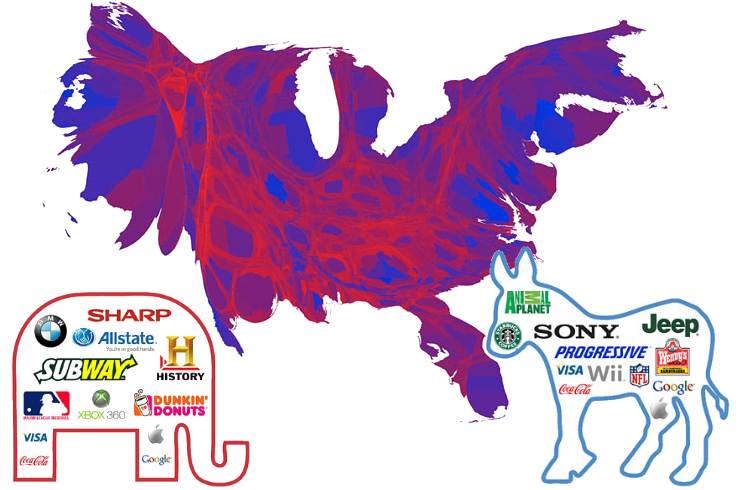Will your neighborhood shine blue or red ?

Our neighborhood rolls down the hills
Through happy farms to the old mill
Green oaks, red doors, enchanting collage
The occasional tremor and a foot massage
The old downtown's still smart and fine
Inclusive, affluent, spiritual, divine
Sumptuous restaurants, boisterous bars
Drones, hoverboards and electric cars
Kids, teens, families and friends
Timeless fashion and youthful trends
Our neighborhood shines blue by day
With bright red specks merged away
Around this place we relax and roam
Admiring more our neighborhood, our home
The past few years have brought about a renaissance in American neighborhoods with strong economies, healthy workforce and diverse communities. Nextdoor has done well to recognize this trend. The simplicity and elegance of Nextdoor's local community network provides a convenient and useful way for residents to stay in touch with their neighbors.
While most people intuitively understand the colloquial definition of "neighborhood", it is an intriguing exercise to research how neighborhoods manifest in spatial and temporal dimensions, along sociological, philosophical and cultural vectors. What makes a neighborhood? How exactly are neighborhoods defined and who defines them? Do the boundaries change over time? How does one find the information for the thousands of neighborhoods and communities across the US? Is there such a thing as a "neighborhood search engine"? Deep knowledge about neighborhoods can set the tone and context for businesses and brands trying to serve the needs of the local market.
As published in a recent blog post, the data scientists at CITYDATA have studied the composition, characteristics, trends and correlations across multiple location-based datasets to understand the physical attributes, the social structure and the digital fabric of local communities. The resulting profiles represent the active identity for each neighborhood, constructed from hundreds of geo-temporal variables, including :
- Crowd-sourced Boundaries
- Fluidity of Geometry
- Local Places & Businesses
- Shops, Malls, Local Services
- Hyper-local Events & Activities
- Local Deals, Promotions, Classifieds
- Town Halls, Libraries, Councils
- Local Authorities, Police, Fire
- Residents, Age, Gender, Ethnicity
- Marital status, Families, Households
- Employment, Income & Occupation
- Education, Schools, Colleges, Scores
- Real Estate, Residential, Commercial
- Political Leanings, Voting Trends
- Spiritual Preferences
- Accidents, Crimes, Natural Disasters
- Alerts, Advisories, Broadcasts
- Weather, and the Environment
Marketers and advertisers look at neighborhoods as a collection of unique people with distinct practices. Neighborhoods provide a sense for the types of audiences one can expect to find in the area, thereby influencing advertising campaign decisions and marketing budget allocations. The increased focus on location-based campaigns in 2016 is starting to put the spotlight back on our neighborhoods.
Neighborhood profiles, structured in the form of APIs, can make it possible for marketers to seamlessly search through unwieldy datasets, to unearth meaningful and actionable intelligence for designing hyper-targeted campaigns. As an example, it would be a marketer's dream to be able to “create and monitor geo-temporal zones, 100 feet in radii, around all café locations in neighborhoods that voted against Prop 8, with median home value above $400K and mean household income over $100K, with an average of 3 members per household, located near venues scheduled to host +5 music events with projected attendance of +1000 per event, with <5% chance of precipitation, over the next 16 weeks”. To enable complex queries like these, CITYDATA has published the detailed profiles for +6800 neighborhoods and made them accessible and searchable through the API and the online dashboard.
Neighborhood insights are of tremendous value to businesses and brands looking to reach the right audience at the right place, the right time and in the right mood. The New York Times recently wrote about national brands running very effective local campaigns that significantly exceeded the industry average for mobile ad engagement. Campari America took a data-centric approach by profiling neighborhoods with a high density of bars in order to reach liquor consumers based on age, demographics and time of day. Their mobile ad used location targeting to present consumers in bars with a discount for a ride-sharing service when they performed specific actions on their smartphones. Regional brands and local businesses can also benefit from targeted campaigns, both digital and physical, powered by neighborhood intelligence. Local restaurants and bars could earn more business by staying open past regular hours to serve audiences exiting late evening music, theater, comedy or sporting events in the neighborhood. Music brands like Fender could accelerate the direct-to-consumer strategy by promoting their instruments at local guitar meetups, jam sessions, and music workshops. Food brands like Pinkberry could monitor neighborhood profiles including youth ratios, ethnicities, income levels, and the microclimate to determine the ideal locations to launch their new froyo flavors, Green Tea and Pina Colada.

Many of us might recollect the amusing online survey by ABC News that revealed Democrats trust brands like Starbucks and Jeep, while Republicans prefer Dunkin Donuts and BMW. While most brands will not take a stand on partisan issues, it turns out that political preferences and the hundreds of other neighborhood attributes can provide deep insights into consumer purchase decisions. Marketers, advertisers, brands, and businesses know this well. As the country gears up for a long-drawn-out election campaign, you can expect marketers to comb through the cities and towns across the US, zoom into your red, white and blue neighborhood, and allocate their green based on the intensity of red or blue.




